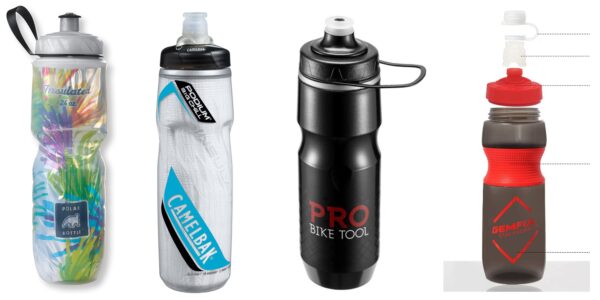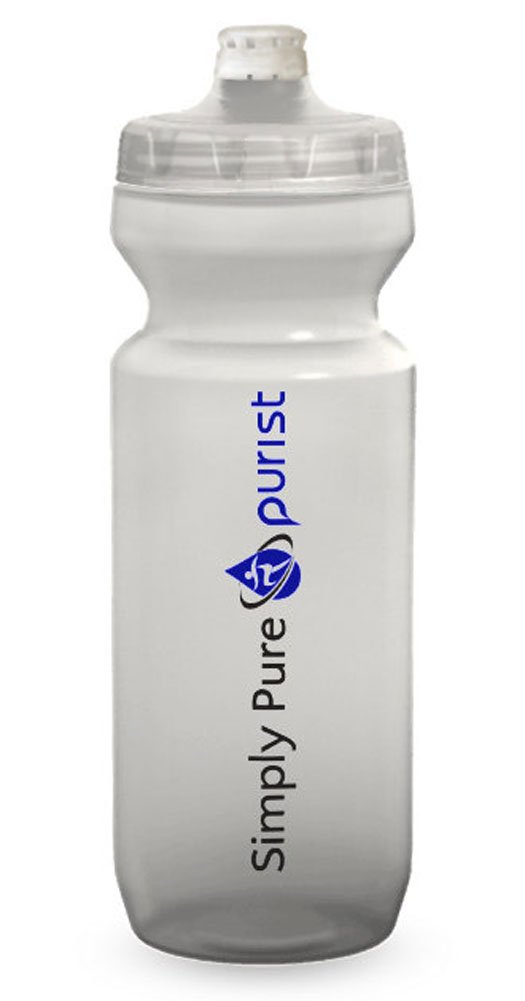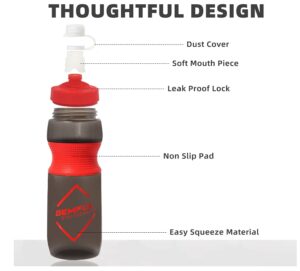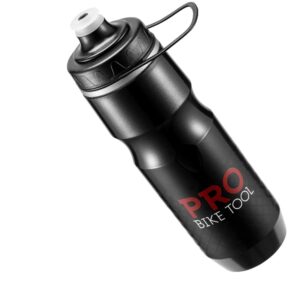
Cycling requires you to drink water. All of that aerobic (and anaerobic) activity will elevate your core temperature, causing you to sweat. You need to replace that sweat with water. The good news is that bikes are cleverly equipped to carry cycling water bottles in cages. Those cycling water bottles are often an afterthought, but like anything else, can be optimized to perform well.
Shape of Cycling Water Bottles
The shape of cycling water bottles is critical to ensure that it remains in your water bottle cage. An ejected bottle can spell doom for a ride; you could be out of water sooner than you thought. Make sure your bottle and cage have a deep enough indentation and tab to retain your bottle well. The shape will also affect how easy it is to return the bottle to the cage. There should be a little bit of taper on the bottom to ease entry. Shape also determines volume. Carrying more water is great, but if a bottle gets too big it can be cumbersome. Carrying less water can be fine if you do not need so much and it could make the bottle easier to handle for shorter rides.
Material of Bottles
Material affects two aspects of cycling water bottles – how easy it is to squeeze and what chemicals it exposes you to. A very stiff bottle will make it harder to squeeze when you need it most along with making the bottle more brittle, possibly affecting its durability.
Science has exposed more and more chemicals recently that detrimentally affect the body. This is after years of use when no one knew what the effects were. Some cycling water bottles tout their lack of certain chemicals in the hope that they will be safer. The most common chemical to drop is BPA, a known endocrine disruptor.
The Nozzle is Key
The nozzle where the water comes out is your closest contact point with cycling water bottles. It can color your entire experience. If the nozzle is hard with a small opening, it will be uncomfortable and will make it difficult to drink. Try a few different bottles to find a nozzle that works for you.
A newer feature of some cycling water bottle nozzles is that they lock. If they end up in the bottom of a bag, they should not leak. When they are unlocked, they are always ready to squirt water with a squeeze.
The top of your cycling water bottle should be a screw-on cap. A pop-on top is asking for it to pull off when you open the nozzle, dumping the contents all of over you.
Cleaning Water Bottles
Cleaning cycling water bottles is critical. If a bottle sits around long enough with water inside it, it will grow all sorts of organisms – bacteria, mold, and mildew, especially if it has left over sports drink mix. How quickly those things grow depend on a few factors: temperature, amount of water, how many organisms were in there to start and what you add to the bottle. The best idea is to clean more often than you think.
The best tool to use is a conical brush. It will be able to reach all of the interior surfaces of the bottle so organisms cannot hide. Use regular dish soap and water. A trick to keep mildew at bay is to use translucent bottles – mildew does not like light.
5 of the Best Cycling Water Bottles
Purist 22 oz Water Bottle by Specialized Bikes
This bottle is the newest gold standard in bottles, after Specialized held the crown for years with their Big Mouth bottles. It has all of the highest tech features: a locking nozzle, BPA free, and a slick surface inside that does not allow organisms to grow and makes it easier to clean.
Price: $16
Gemful Bottle With Dust Cap
Gemful are one of the few bottles that consider the dust and mud that can collect on the nozzle. They include an attach dust cover that is easy to remove while riding. This one is the perfect water bottle for mountain bikers.
Price: $17
CamelBak Podium Big Chill
CamelBak were the originators of the locking nozzle. The design still works well. An insulated bottle like this will keep your water cooler and more refreshing deeper into your ride. Conversely, if it’s cold out, adding warm water will keep from freezing for longer.
Price: $29
Pro Bike Tool Soft Bottle
Pro Bike Tool bottles use flexible HET (High Elastic Technology) material which delivers ‘More Fluid with Less Effort. BPA free and dishwash-safe – this is a great go-to for most rides.
Price: $19
Polar Insulated Bottle
These Polar Bottles are the most popular insulated bottle. They are also BPA and Pthalate free to keep you from ingesting unhealthy chemicals. They can keep contents both cold and warm. They also come in a huge variety of colors as you can see above. Their are over 30 options for you to choose from.
Price: $10-30 on average.
Bottles Matter
By thinking a little about the cycling water bottles you use, you can optimize your riding a little bit more. It may mean being able to drink more, carrying more, or being more comfortable.





